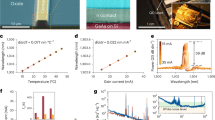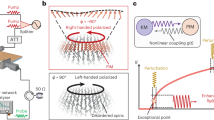Abstract
Multimode optical fibres are enjoying renewed attention, boosted by the urgent need to overcome the current capacity crunch of single-mode fibre (SMF) systems and by recent advances in multimode complex nonlinear optics1,2,3,4,5,6,7,8,9,10,11,12,13. In this work, we demonstrate that standard multimode fibres (MMFs) can be used as ultrafast all-optical tools for the transverse beam manipulation of high-power laser pulses. Our experimental data show that the Kerr effect in a graded-index (GRIN) MMF is the driving mechanism that overcomes speckle distortions, and leads to a counterintuitive effect that results in a spatially clean output beam robust against fibre bending. Our observations demonstrate that nonlinear beam reshaping into the fundamental mode of a MMF can be achieved even in the absence of a dissipative process such as stimulated scattering (Raman or Brillouin)14,15.
This is a preview of subscription content, access via your institution
Access options
Access Nature and 54 other Nature Portfolio journals
Get Nature+, our best-value online-access subscription
$29.99 / 30 days
cancel any time
Subscribe to this journal
Receive 12 print issues and online access
$209.00 per year
only $17.42 per issue
Buy this article
- Purchase on Springer Link
- Instant access to full article PDF
Prices may be subject to local taxes which are calculated during checkout





Similar content being viewed by others
References
Richardson, D. J., Nilsson, J. & Clarkson, W. A. High power fiber lasers: current status and future perspectives. J. Opt. Soc. Am. B 27, B63–B92 (2010).
Richardson, D. J., Fini, J. M. & Nelson, L. E. Space division multiplexing in optical fibers. Nat. Photon. 7, 354–362 (2013).
Wright, L. G., Christodoulides, D. N. & Wise, F. W. Controllable spatiotemporal nonlinear effects in multimode fibres. Nat. Photon. 9, 306–310 (2015).
Wright, L. G., Wabnitz, S., Chistodoulides, D. N. & Wise, F. W. Ultrabroadband dispersive radiation by spatiotemporal oscillation of multimode waves. Phys. Rev. Lett. 115, 223902 (2015).
Renninger, W. H. & Wise, F. W. Optical solitons in graded-index multimode fibres. Nat. Commun. 4, 1719 (2013).
Yu, S.-S., Chien, Ch.-H., Lai, Y. & Wang, J. Spatio-temporal solitary pulses in graded-index materials with Kerr nonlinearity. Opt. Commun. 119, 167–170 (1995).
Gurgov, H. C. & Cohen, O. Spatiotemporal pulse-train solitons. Opt. Express 17, 7052–7058 (2009).
Burgess, I. B., Peccianti, M., Assanto, G. & Morandotti, R. Accessible light bullets via synergetic nonlinearities. Phys. Rev. Lett. 102, 203903 (2009).
Picozzi, A., Millot, G. & Wabnitz, S. Nonlinear virtues of multimode fibre. Nat. Photon. 9, 289–291 (2015).
Longhi, S. Modulational instability and space–time dynamics in nonlinear parabolic-index optical fibers. Opt. Lett. 28, 2363–2365 (2003).
Buch, S. & Agrawal, G. P. Soliton stability and trapping in multimode fibers. Opt. Lett. 40, 225–228 (2015).
Krupa, K. et al. Observation of geometric parametric instability induced by the periodic spatial self-imaging of multimode waves. Phys. Rev. Lett. 116, 183901 (2016).
Wright, L. G. et al. Self-organized instability in graded-index multimode fibres. Nat. Photon. 10, 771–776 (2016).
Chiang, K. S. Stimulated Raman scattering in a multimode optical fiber: self-focusing or mode competition? Opt. Commun. 95, 235–238 (1993).
Terry, N. B., Alley, T. G. & Russell, T. H. An explanation of SRS beam cleanup in graded-index fibers and the absence of SRS beam cleanup in step-index fibers. Opt. Express 15, 17509–17519 (2007).
Barmes, I., Witte, S. & Eikema, K. S. E. Spatial and spectral coherent control with frequency combs. Nat. Photon. 7, 38–42 (2013).
Mahalati, R. N., Askarov, D., Wilde, J. P. & Kahn, J. M. Adaptive control of input field to achieve desired output intensity profile in multimode fiber with random mode coupling. Opt. Express 20, 14321–14337 (2012).
Papadopoulos, I. N., Farahi, S., Moser, Ch. & Psaltis, D. Focusing and scanning light through a multimode optical fiber using digital phase conjugation. Opt. Express 20, 10583–10590 (2012).
Plöschner, M., Tyc, T. & Čižmár, T. Seeing through chaos in multimode fibres. Nat. Photon. 9, 529–535 (2015).
Lombard, L., Brignon, A., Huignard, J.-P. & Lallier, E. Beam cleanup in a self-aligned gradient-index Brillouin cavity for high-power multimode fiber amplifiers. Opt. Lett. 31, 158–160 (2006).
Lushnikov, P. M. & Vladimirova, N. Nonlinear combining of laser beams. Opt. Lett. 39, 3429–3432 (2014).
Ascheri, P., Garnier, G., Michel, C., Doya, V. & Picozzi, A. Condensation and thermalization of classical optical waves in a waveguide. Phys. Rev. A 83, 033838 (2011).
Mafi, A. Pulse propagation in a short nonlinear graded-index multimode optical fiber. J. Light. Technol. 30, 2803–2811 (2012).
Trillo, S. & Wabnitz, S. Nonlinear nonreciprocity in a coherent mismatched directional coupler. Appl. Phys. Lett. 49, 752–754 (1986).
Hellwig, T., Schnack, M., Walbaum, T., Dobner, S. & Fallnich, C. Experimental realization of femtosecond transverse mode conversion using optically induced transient long-period grating. Opt. Express 22, 24951–24958 (2014).
Anglin, J. R. & Vardi, A. Dynamics of a two-mode Bose-Einstein condensate beyond mean-field theory. Phys. Rev. A 64, 013605 (2001).
Poletti, F. & Horak, P. Dynamics of femtosecond supercontinuum generation in multimode fibers. Opt. Express 17, 6134–6147 (2009).
Marcuse, D. Theory of Dielectric Optical Waveguides (Academic, 1974).
Modotto, D. et al. Ge-doped microstructured multicore fiber for customizable supercontinuum generation. IEEE Photon. J. 3, 1149–1156 (2011).
Sun, C. et al. Observation of the kinetic condensation of classical waves. Nat. Phys. 8, 470–474 (2012).
Picozzi, A. et al. Optical wave turbulence: towards a unified nonequilibrium thermodynamic formulation of statistical nonlinear optics. Phys. Rep. 542, 1–132 (2014).
Acebron, J. A., Bonilla, L. L., Pérez Vicente, C. J., Ritort, F. & Spigler, R. The Kuramoto model: a simple paradigm for synchronization phenomena. Rev. Mod. Phys. 77, 137–185 (2005).
Acknowledgements
K.K., A.T., B.M.S., M.F., A.B. and V.C. acknowledge the financial support provided by Bpifrance OSEO (Industrial Strategic Innovation Programme) and Horiba Médical (Dat@diag no. I1112018W), by Région Limousin (C409-SPARC) and ANR Labex SIGMA-LIM. S.W. acknowledges support by the Italian Ministry of University and Research (MIUR) (grants 2012BFNWZ2 and 2015KEZNYM), the European Community via the Horizon 2020 CARDIALLY project and the Ministry of Education and Science of the Russian Federation (14.Y26.31.0017). G.M. acknowledges support from the iXcore research foundation, Photcom Région Bourgogne and ANR Labex Action. The authors thank F. Wise, L. Wright, Z. Liu and A. Picozzi for valuable discussions.
Author information
Authors and Affiliations
Contributions
K.K. and V.C. carried out the experiments. A.T. and S.W. performed the numerical simulations and theoretical analysis. All the authors analysed and interpreted the obtained results, and participated equally in the discussions and in the writing of the manuscript.
Corresponding author
Ethics declarations
Competing interests
The authors declare no competing financial interests.
Supplementary information
Supplementary Information
Supplementary Information (PDF 7325 kb)
Supplementary Information
Supplementary Movie 1 (MP4 725 kb)
Supplementary Information
Supplementary Movie 2 (MP4 1060 kb)
Supplementary Information
Supplementary Movie 3 (MP4 1681 kb)
Supplementary Information
Supplementary Movie 4 (MP4 6752 kb)
Rights and permissions
About this article
Cite this article
Krupa, K., Tonello, A., Shalaby, B. et al. Spatial beam self-cleaning in multimode fibres. Nature Photon 11, 237–241 (2017). https://doi.org/10.1038/nphoton.2017.32
Received:
Accepted:
Published:
Issue Date:
DOI: https://doi.org/10.1038/nphoton.2017.32
This article is cited by
-
Spectral-temporal-spatial customization via modulating multimodal nonlinear pulse propagation
Nature Communications (2024)
-
Statistics of modal condensation in nonlinear multimode fibers
Nature Communications (2024)
-
Real-time observation of optical rogue waves in spatiotemporally mode-locked fiber lasers
Communications Physics (2023)
-
Theory of localization-hindered thermalization in nonlinear multimode photonics
Communications Physics (2023)
-
Agar-based optical sensors for electric current measurements
Scientific Reports (2023)



